Physical Address
304 North Cardinal St.
Dorchester Center, MA 02124
Physical Address
304 North Cardinal St.
Dorchester Center, MA 02124
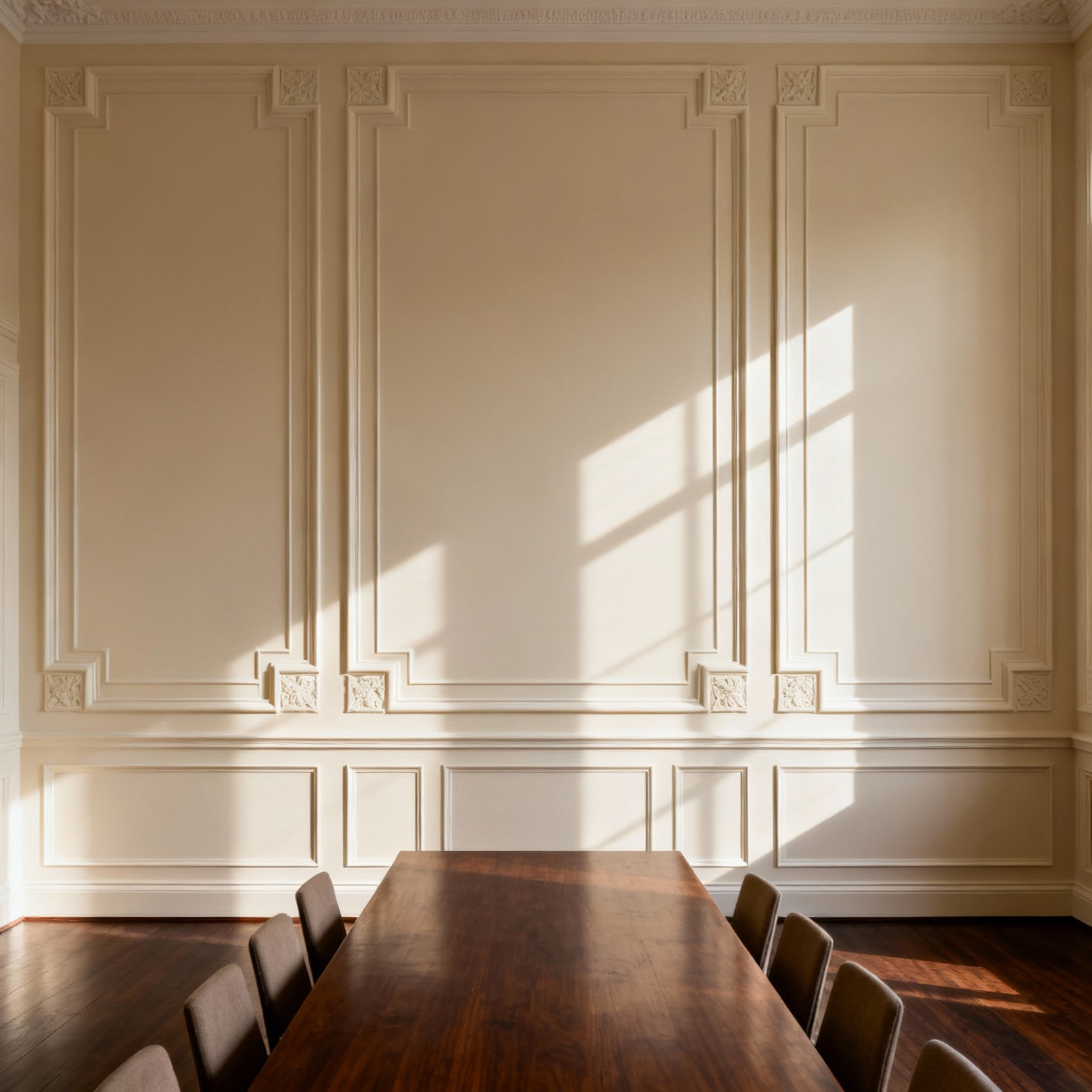
Transform your dining space from basic to bespoke. Discover 16 expert-level dining room wall decor secrets, focusing on architectural paneling, acoustic texture, and strategic lighting.
In my years designing interiors for five-star hotels, I learned a fundamental truth: furniture does not define a space—feeling does. There is a distinct divide between a room and a destination. A dining room merely holds a table and chairs, serving a functional necessity. A *destination*, however, captures you the moment you cross the threshold, transporting you to a distinct mood or memory. This shift turns a home from a place you simply exist in to a space you actively experience, and it begins with sophisticated dining room wall decor.
This transformation relies heavily on the envelope of the room. We must view wall decor not as an afterthought, but as the primary vehicle for storytelling. When you treat your vertical space as an immersive canvas rather than a spot for random prints, you stop decorating and start curating. The energy shifts; the space invites lingering conversation and intimate connection, urging guests to stay long after the dessert wine is poured.
Below, I am sharing the insider design strategies used to turn standard residential eating areas into captivating hospitality experiences. We will explore how to elevate walls into emotional focal points and integrate lighting that mimics the glow of an exclusive private club. By prioritizing purpose over mere aesthetics, you will discover how to craft a visual narrative that resonates. Let’s transform your dining space from a place to eat into a place to be.
Luxury begins with the “envelope,” not the accessories. In high-end hotel design, we never rely on artwork to fix a flat room; instead, we build interest directly into the architecture. Treat your walls as a permanent canvas by installing structural details like wainscoting or picture frame molding first. These elements capture light and create natural shadows, effectively handling the majority of the decorative heavy lifting before a single painting is hung.

Once the structure is set, apply a cohesive finish to unify the space.
By prioritizing these foundational architectural elements, you establish a rich baseline that makes every subsequent design choice effortless.
Standard wainscoting can sometimes visually stunt a room. In boutique hotel lobbies, we often extend millwork from baseboard to crown molding to transform flat drywall into a high-end architectural shell. This floor-to-ceiling approach elevates the room’s “bones,” making the space feel custom and substantial rather than merely furnished. To achieve this bespoke look without a renovation-sized budget, focus on three key execution strategies:
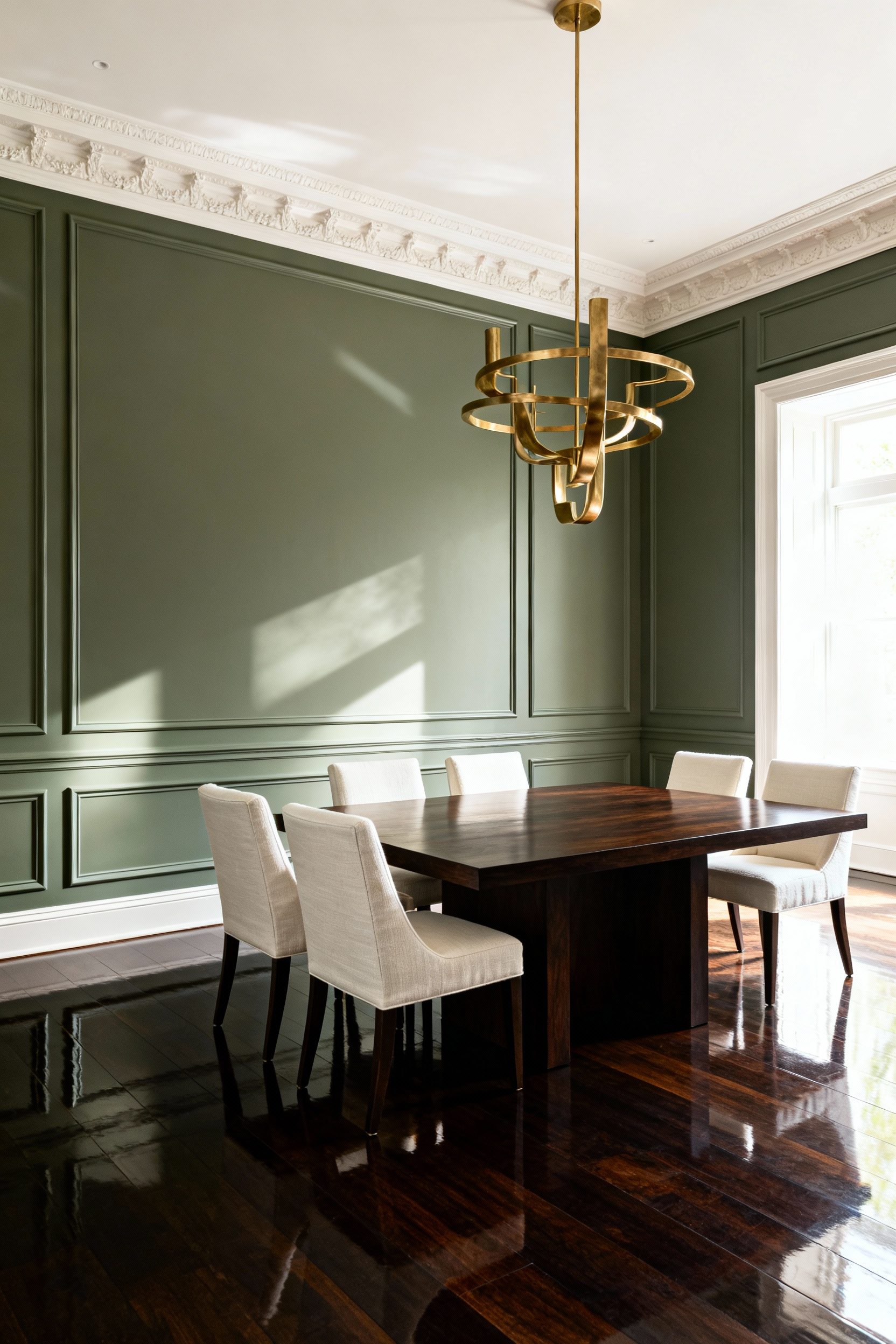
This technique makes the dining room feel taller and infinitely more grand. By integrating these architectural elements, you create a cohesive, immersive environment that defines the room’s identity.
While visuals are important, acoustics are vital. Homeowners often overlook that hard surfaces like marble tables and hardwood floors create harsh echoes that can ruin the mood. In high-end hotel design, we rigorously engineer dining spaces to absorb sound, ensuring guests never shout over clinking silverware. Upholstered wall panels offer the ultimate solution. By absorbing reverberation, these plush surfaces clarify speech and foster the intimate, hushed atmosphere found in the world’s finest restaurants.
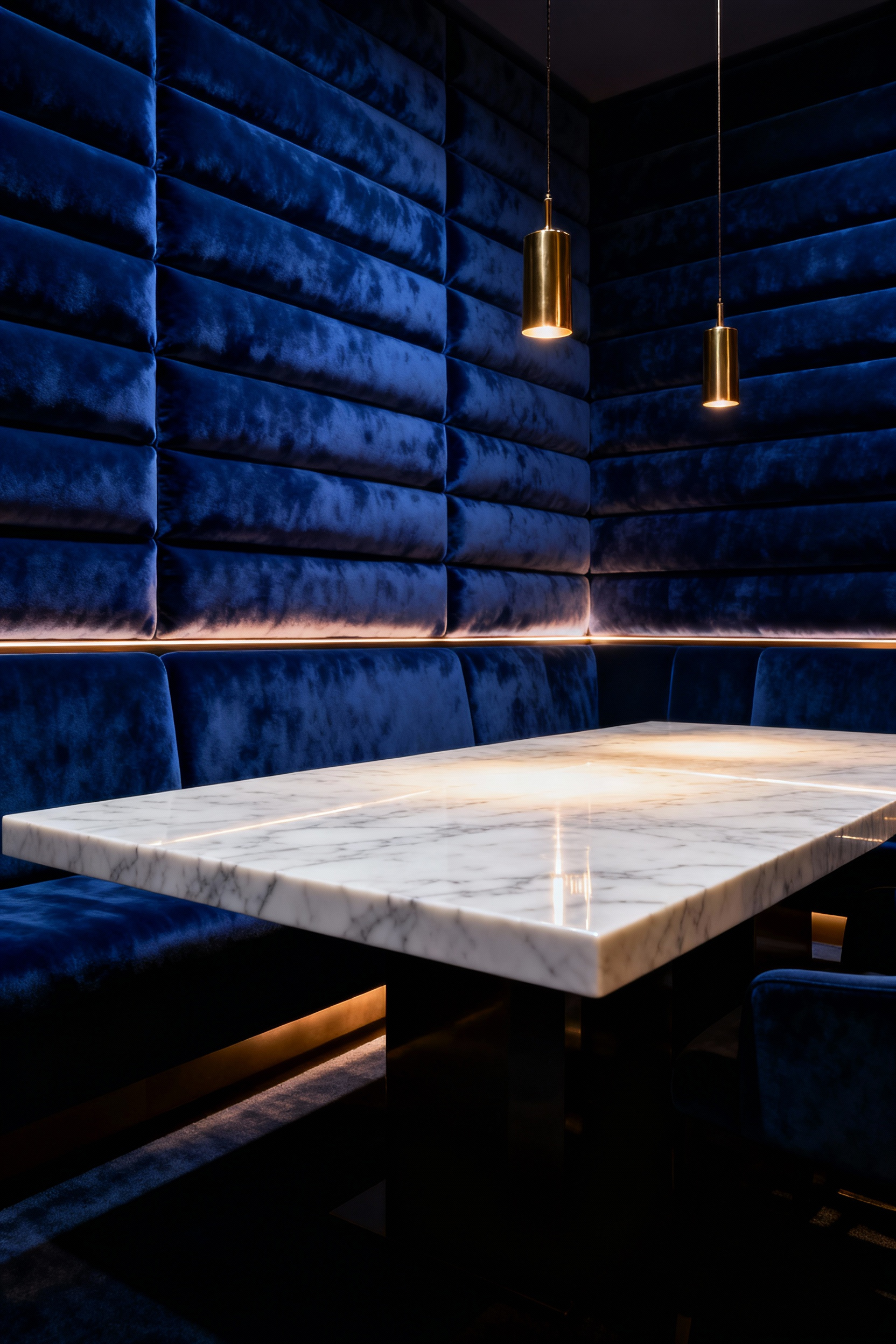
This design choice delivers a sophisticated dual purpose: the fabric adds visual warmth, while the hidden padding actively dampens noise. You need not wrap the entire room; simply installing panels on one accent wall effectively stops noise bounce-back. Practicality remains paramount in a dining environment, so when selecting materials, prioritize hospitality-grade features:
Treat your dining area like a VIP suite. This strategic upgrade transforms a noisy, echoing room into a sanctuary of conversation and comfort.
High-end design appeals to the touch, not just the eye. I rarely rely on flat paint to set a seductive mood; instead, envelop guests in the rich, tactile dimension of silk or grasscloth. These materials transform walls into dynamic backdrops. To maximize this effect, position sconces or art lights to graze the wall’s surface. The light catches the natural fibers or silk sheen, creating shadows and highlights that flat color simply cannot match. Selecting deep hues like charcoal or navy amplifies the drama. The texture prevents these dark colors from feeling heavy, creating a sophisticated cocoon that makes white trim and artwork pop.
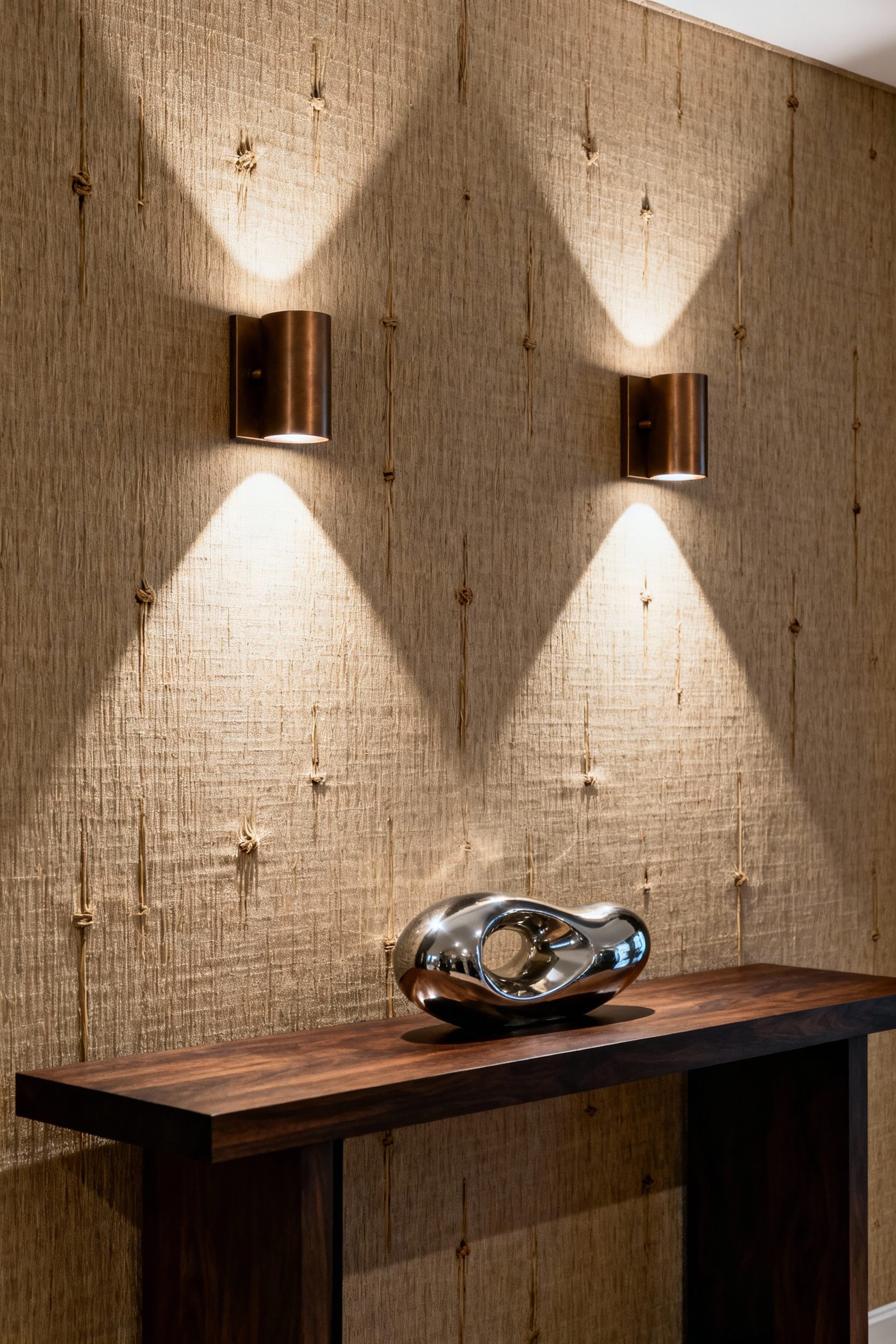
Natural fibers are delicate and prone to staining. Protect your investment by installing these materials above wainscoting, keeping the luxury at eye level while shielding the lower wall from chair scuffs and wine spills. For busy households, I frequently specify Type II Vinyl—a hospitality trade secret that mimics the look of natural grasscloth but wipes clean effortlessly. Regardless of the material, embrace the inherent character of textured wallcoverings:
We never view the ceiling as an afterthought in hotel design; we treat it as the “fifth wall,” a crucial canvas for creating an immersive atmosphere. Breaking the visual flow with a standard builder-white ceiling instantly cheapens a room’s aesthetic. Instead, extend your dining room’s elegance upward to captivate your guests. Start by blurring the boundaries with “color drenching.” Paint your walls, cornices, and the ceiling in a single, rich tone. This technique eliminates harsh lines, enveloping diners in a sophisticated cocoon that creates intimacy.
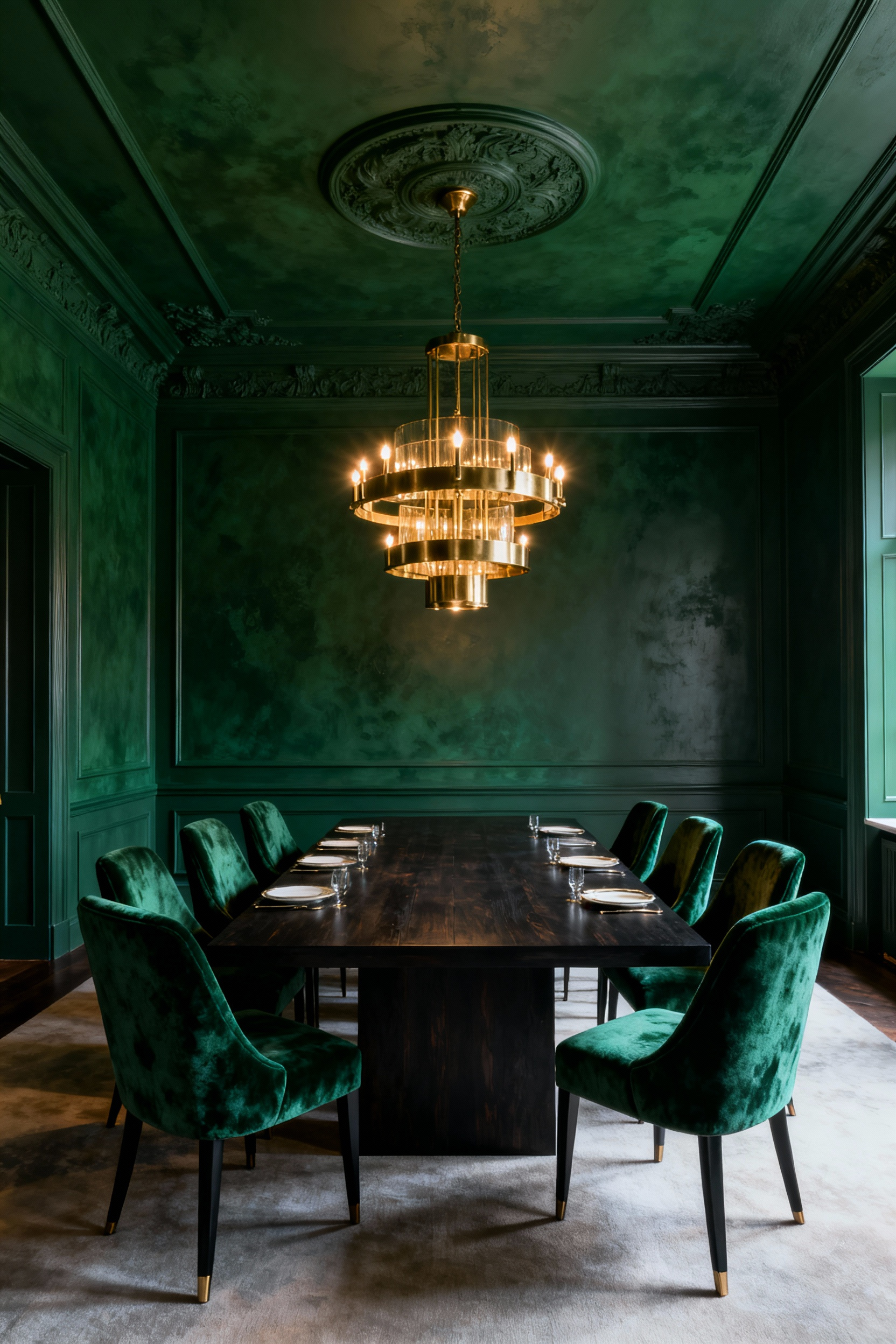
To truly elevate the space, replace flat surfaces with intentional architectural character.
These details draw the eye upward, expanding the perceived volume of the room while delivering the polished, cohesive feel found in the world’s finest dining salons.
Applied box work introduces architectural gravitas to dining spaces without creating visual clutter. This technique creates a soothing rhythm through precise repetition. To achieve this professional cadence, precision is non-negotiable. Cut a spacer block to a set width, typically three or six inches, and use it to measure the gap between every box. This simple trick guarantees the flawless uniformity required for a high-end finish.
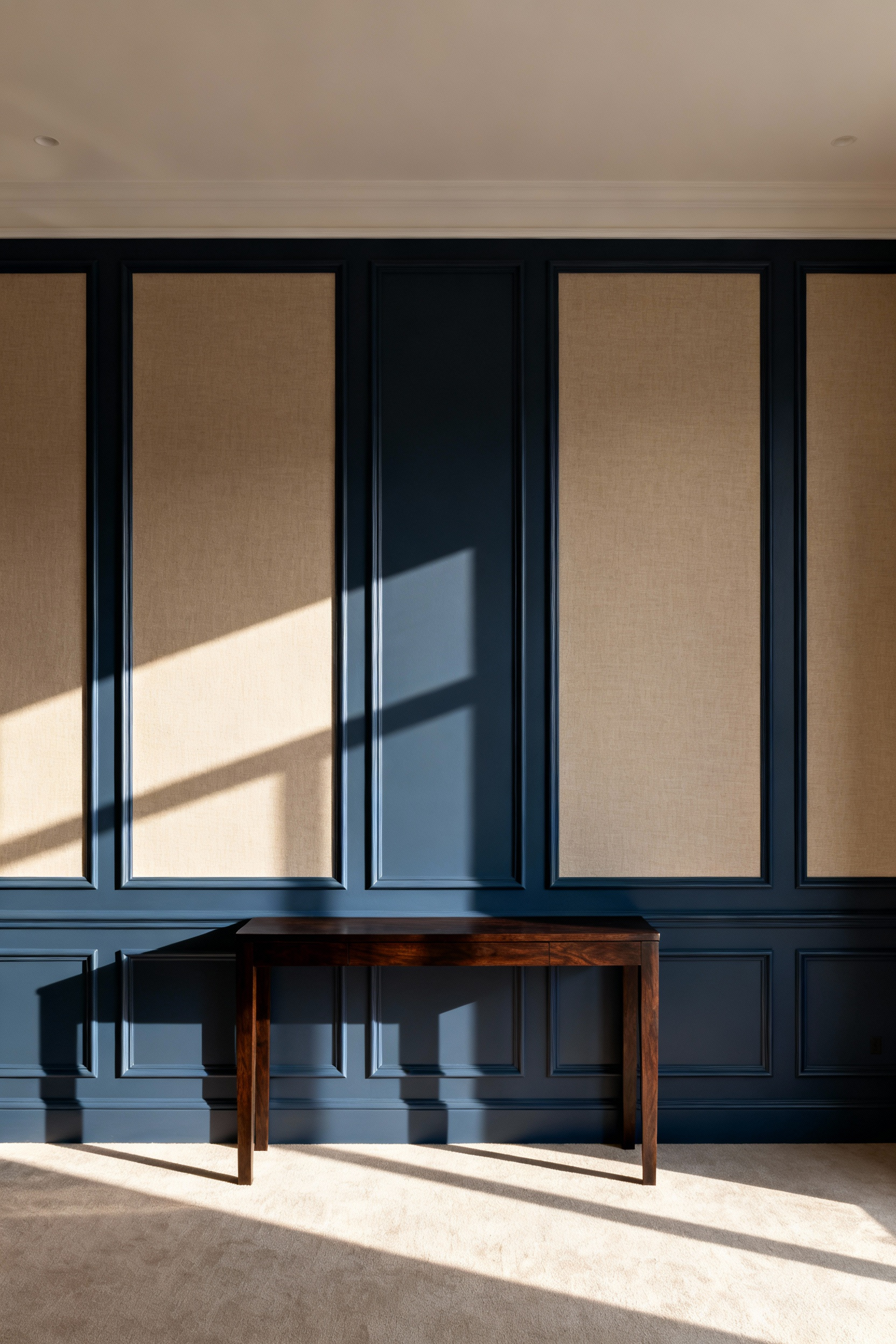
Beyond spacing, the vertical layout dictates the room’s atmosphere. Extending the moulding from the baseboard to the ceiling draws the eye upward, making the space feel grander and more expansive. To maximize this sophisticated effect:
In five-star hotel design, lighting functions as the room’s jewelry; it dictates the emotional temperature of the space. Therefore, you must manipulate luminosity through strategic reflection to achieve true sophistication. Position a grand mirror or mirrored panels directly opposite your chandelier or window. This placement instantly doubles the visual depth and maximizes brightness, mimicking the expansive feel of a grand ballroom. To replicate the flattering, “golden hour” glow found in exclusive dining lounges, apply these specific hospitality techniques:

This grants you total control over the ambiance, allowing you to shift effortlessly from a bright, functional brunch setting to an intimate, candlelit evening atmosphere. Luxury is not just about what you see, but how the light makes your guests feel.
One secret weapon for manipulating space without sacrificing intimacy is the smoked glass mirror grid. Unlike standard high-definition mirrors, the antiqued or smoked finish intentionally softens reflections into a foggy, romantic blur. This crucial detail expands the visual boundaries of your dining room while preventing the distraction of guests watching themselves eat. The room feels vast yet undeniably cozy, mimicking the sophisticated privacy of an exclusive members’ club.

The grid structure provides necessary architectural weight, transforming a flat sheet of glass into a faux window that adds depth rather than just surface area. For the most luxurious impact, strategic placement is non-negotiable:
Lighting dictates the mood, and articulating sconces bring adaptable, restaurant-quality sophistication directly into your home. These swing-arm fixtures bridge the gap between function and form. If your dining table doubles as a workspace, simply pull the light out for focused tasks. Later, push it back against the wall to clear the visual clutter for dinner. This wall-mounted approach also frees up precious surface area on sideboards, maximizing utility in smaller rooms without sacrificing style.

To achieve a polished, architectural look, flank a statement mirror or artwork with a symmetrical pair of sconces. This arrangement instantly creates a focal point and adds visual balance. Crucially, treat the light quality as a vital ingredient in your design.
By controlling the intensity and direction of the light, you banish harsh shadows and craft a luxurious, inviting atmosphere.
Hospitality design relies on lighting to curate atmosphere, not just fixtures. You can replicate this five-star ambiance by positioning an oversized antiqued mirror against your dining wall. Unlike crisp modern glass, the distressed finish softens reflections, adding sophisticated depth without harsh glare. The “leaner” style instantly makes spaces feel grander and more relaxed, treating your room to a casual yet opulent upgrade.
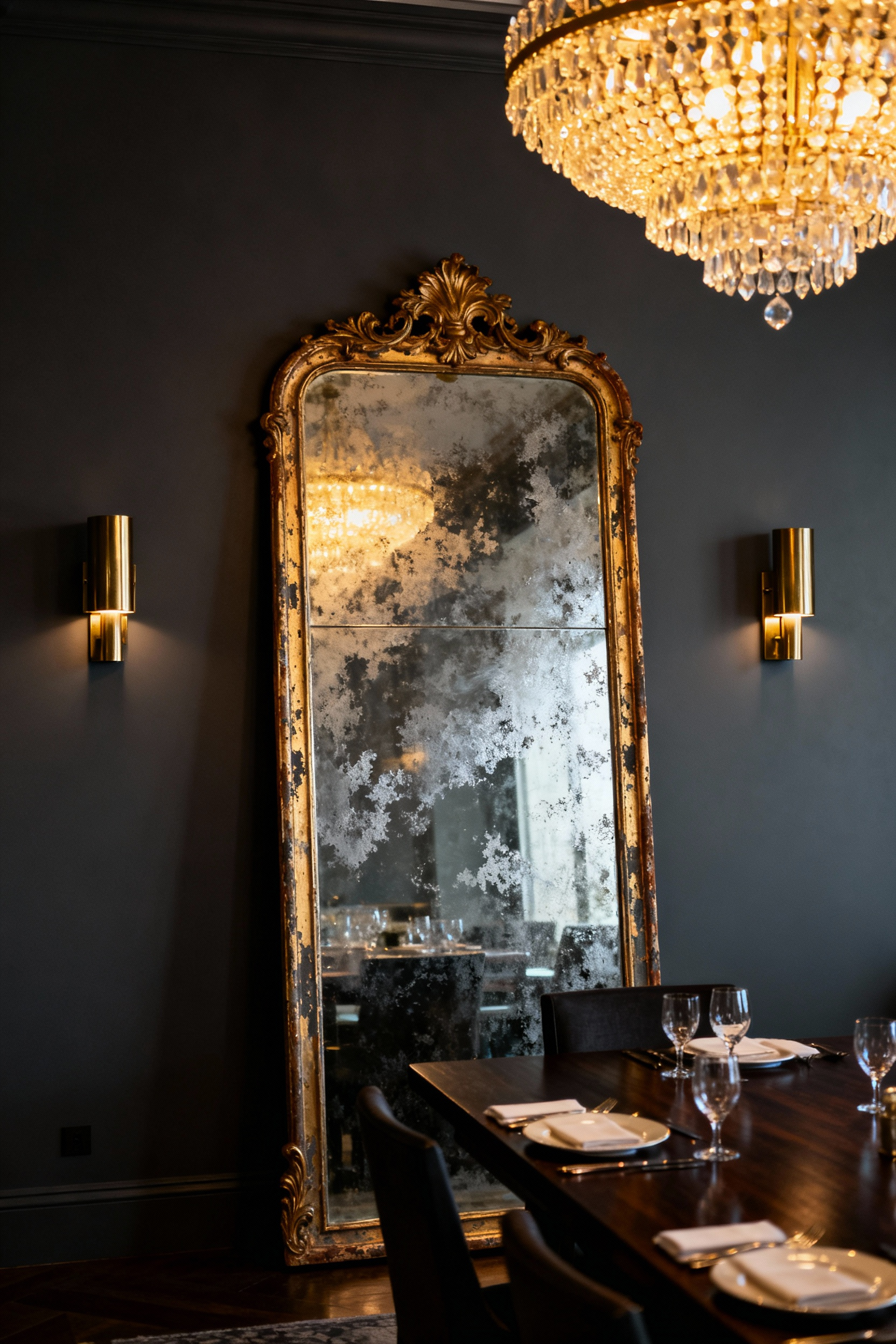
To truly master the evening glow, treat the mirror as a canvas for light.
This creates a dual focal point that doubles the visual impact of your finest decor while making the room feel warm and expansive.
Think of a picture light as the final touch of jewelry on an elegant ensemble. We use these fixtures in high-end spaces to direct the guest’s gaze and elevate the room’s perceived value instantly. Choose a finish—such as antique brass or polished nickel—that creates a deliberate dialogue with your cabinet pulls or chandelier, ensuring the hardware acts as a sophisticated accessory. To ensure the fixture honors the art rather than distracting from it, apply these professional standards:

This technical precision grants you total control over the evening’s narrative. Keep the light bright to showcase intricate details during arrival, then lower it to a soft, ambient wash as the main course is served. This simple adjustment transforms static decor into a dynamic element of your dining experience.
High-gloss lacquer serves as the ultimate secret weapon for atmospheric drama, transforming a static room into a seductive, jewel-box environment. To achieve this level of residential luxury, select saturated tones like deep charcoal or navy, then color-drench both walls and ceilings. However, execute this with caution. The glass-like finish magnifies every imperfection, so you must budget for professional surface preparation. Your walls must be perfectly smooth, or the luxurious illusion shatters.
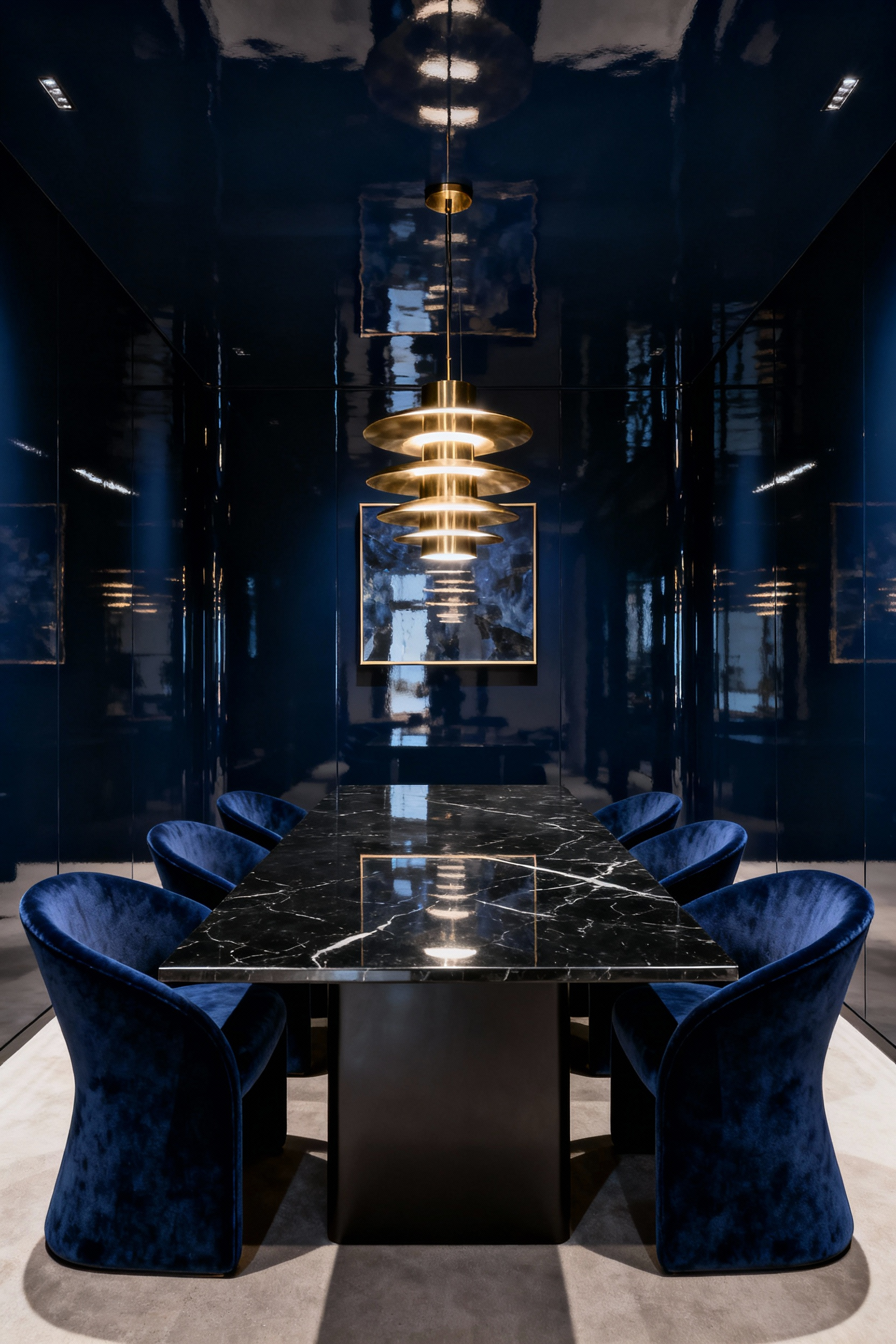
Once applied, the lacquer amplifies the glow of chandeliers and sconces, creating a luminous depth ideal for intimate evening dining. Nevertheless, too much shine feels sterile. Ground the high-glamour aesthetic by layering in matte, tactile elements to balance the reflection:
This intentional contrast prevents the room from feeling cold, ensuring a sophisticated, multi-layered experience that feels distinctively expensive.
In high-end hospitality, we view wall decor as the room’s narrative arc, not mere filler. Your dining room demands this same intentional curation. Define your artistic statement by selecting a palette that enhances the mood; warm tones like deep ochres or terracottas stimulate appetite and lively conversation. However, scale dictates impact. Adhere strictly to the two-thirds rule when hanging pieces above a sideboard or buffet. The artwork must occupy two-thirds to three-quarters of the furniture’s width. Anything less looks diminished and accidental rather than grand and intentional.

Select a format that aligns with your desired energy.
Finally, illuminate your curation. In luxury suites, we never leave art in the dark. Install dedicated picture lights or angled track lighting to transform flat images into commanding textures. Without proper illumination, even the most exquisite collection becomes invisible once the sun sets.
Lobbies rely on one secret weapon: scale. To bring this grandeur to your dining room, bypass cluttered gallery walls and select a single, expansive monochromatic piece that spans at least two-thirds of the wall width. This creates an immediate, sophisticated anchor that defines the space. However, true luxury requires precise execution:
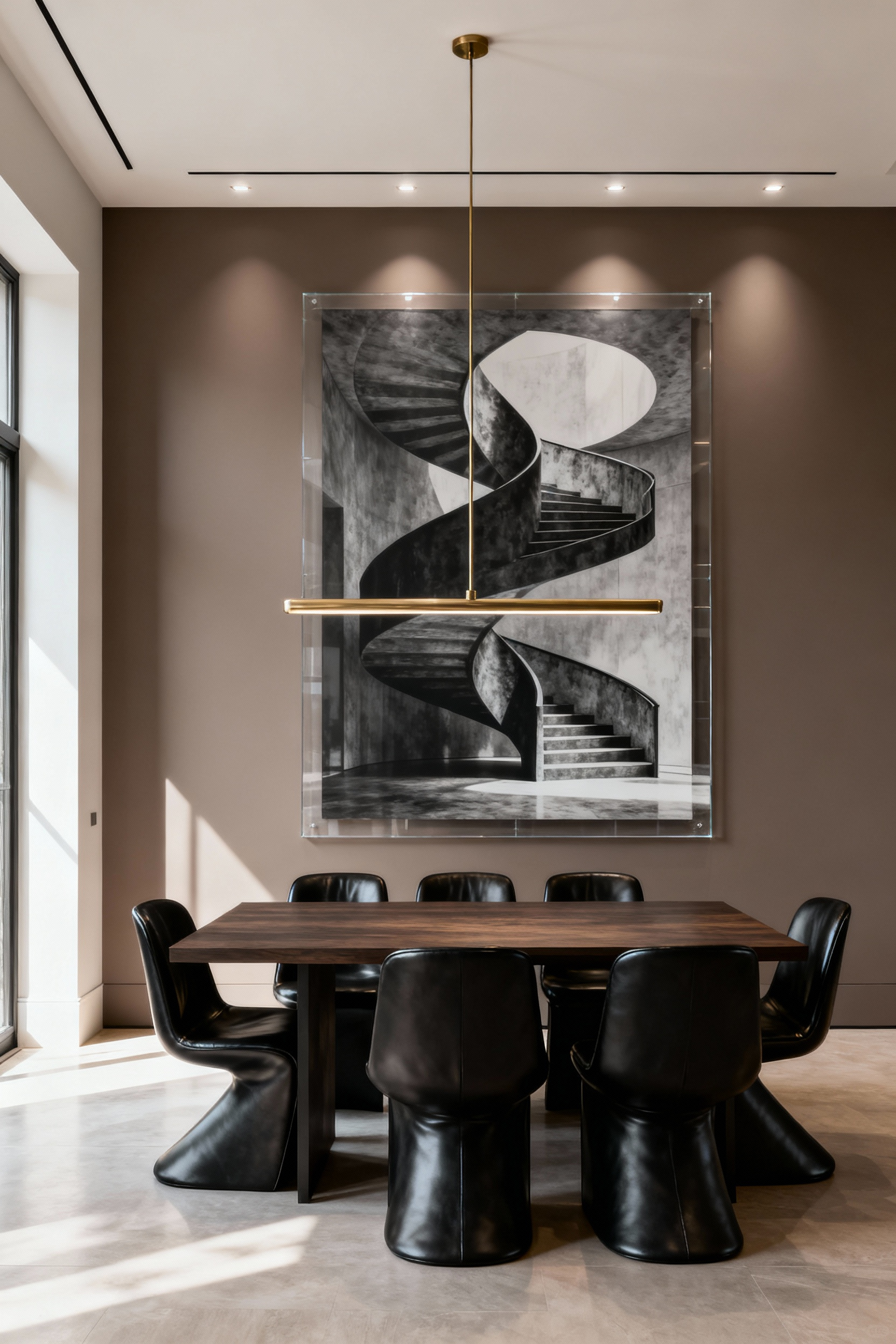
By prioritizing high-contrast imagery over color, you achieve a timeless aesthetic that feels expensive, calm, and intentionally curated.
Elevate your hosting experience by abandoning the bulky floor cart for a sleek, wall-mounted “Concierge” station. We maximize modest footprints in boutique hotel design by utilizing vertical real estate to create drama and utility simultaneously. Install floating shelves in premium materials like live-edge wood or brass-finished metal to anchor the room, instantly reclaiming floor space while establishing a sophisticated focal point. This transforms a mere storage solution into a dedicated service hub that feels exclusive and bespoke.

The secret to that exclusive lounge atmosphere lies entirely in curation and illumination. Treat your liquor collection as art rather than inventory. To achieve this high-end aesthetic:
By properly lighting your vertical display, you create an ambient evening mood that invites guests to serve themselves with the ease of a VIP lounge.
We rarely settle for flat walls in luxury design; we demand texture. Sculptural reliefs transform a static dining room into a dynamic experience, catching the eye with depth rather than just color. To replicate this high-end drama, you must prioritize the interaction between form and light. Install directional spotlights directly above the piece to cast deliberate shadows. This simple adjustment amplifies the artwork’s three-dimensional nature and instantly elevates the room’s ambiance.
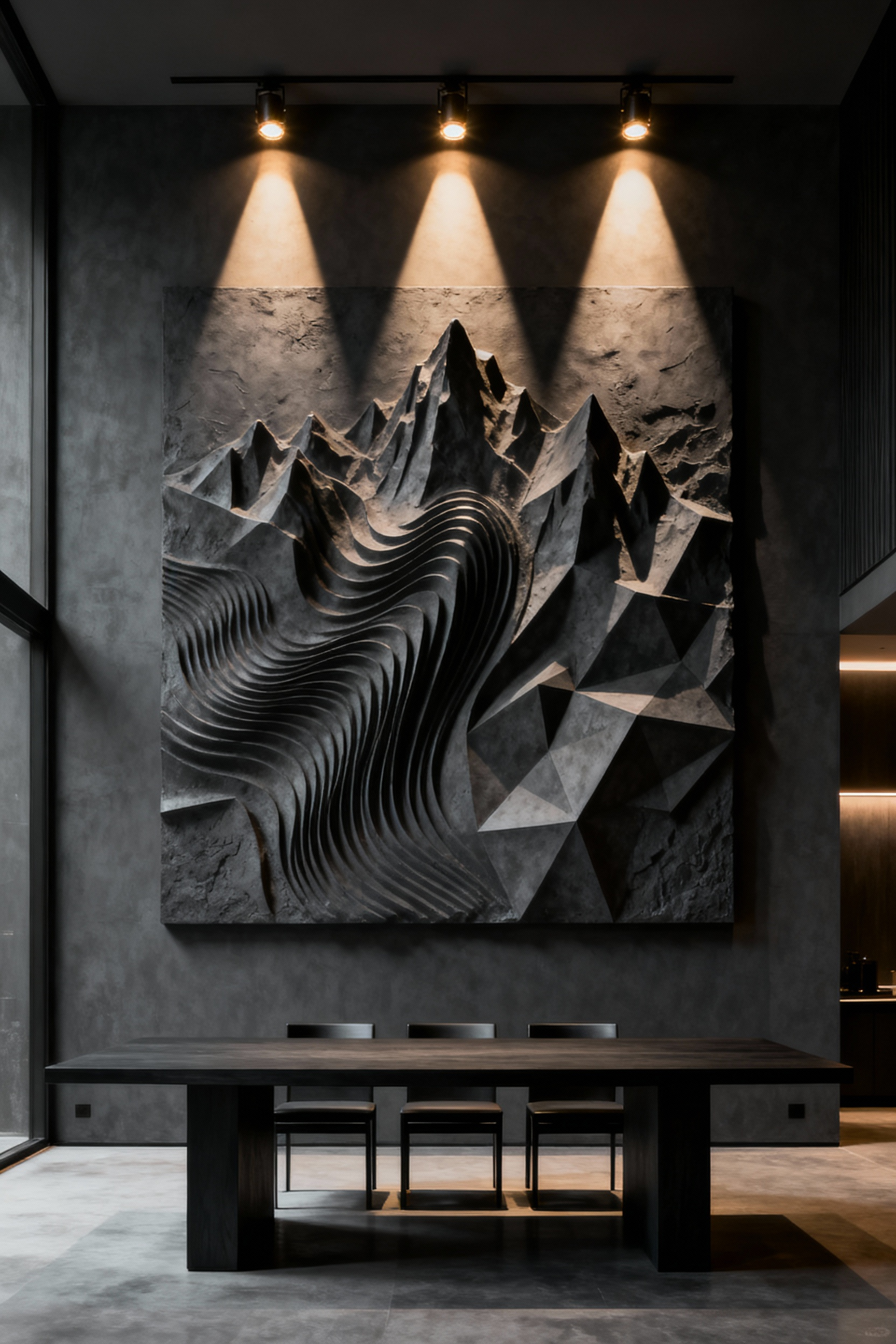
Select your medium based on the specific mood you wish to curate:
Ensure visual balance by sizing the relief to approximately two-thirds the width of the furniture below it. This anchors the space effectively. For a truly collected aesthetic, mix these dimensional pieces with traditional framed art to build a gallery wall rich in contrast and sophistication.
Visual rhythm defines the guest experience in luxury hotels. Unlike the erratic energy of a salon wall, the Grid Gallery employs Disciplined Curation to command the room. I often utilize this technique in hotel suites to foster immediate tranquility. Transform your dining space by enforcing strict uniformity; select identical frames and crisp white mats for every piece. This repetition creates a cohesive architectural statement, proving that true luxury lies in rigorous consistency rather than distinct, expensive items.
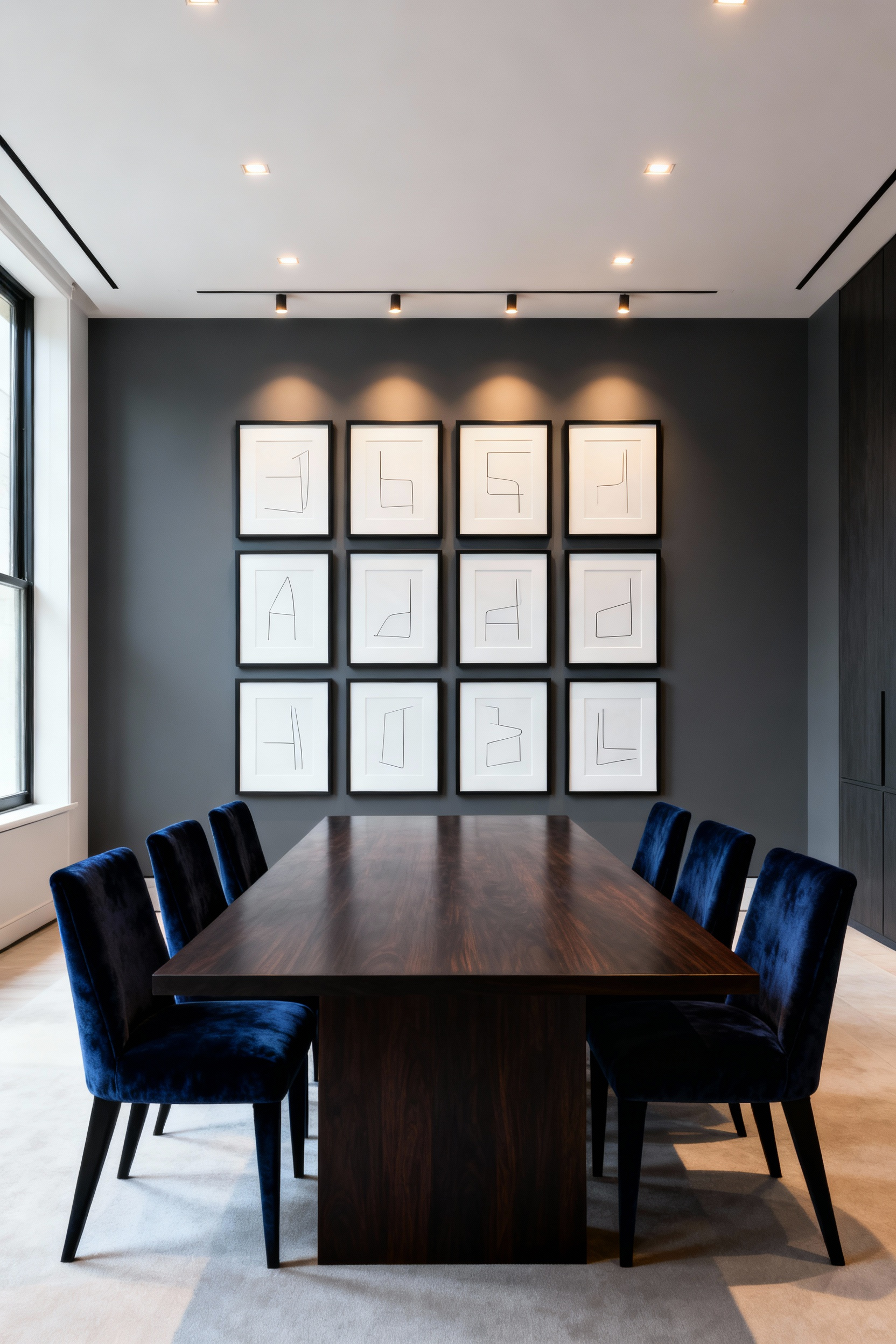
Precision elevates the installation from simple decor to art. To replicate that high-end lobby aesthetic, follow these non-negotiable standards:
Consequently, your dining room gains a sophisticated, restful backdrop that allows conversation, not chaos, to take center stage.
We obsess over acoustics just as much as aesthetics in high-end design. A noisy dining room destroys ambiance, but vertical preserved moss serves as a sophisticated solution. These lush installations act as powerful sound dampeners, softening echoes to ensure your dinner conversation remains intimate and distinct. You achieve a sensory experience comparable to the world’s finest restaurants without the humidity or labor of a living wall. Since preserved moss is dormant, it requires absolutely zero watering or pruning, allowing you to enjoy permanent greenery with effortless grace.

Treat these installations as commissioned sculpture rather than simple plant life. To create a truly luxurious focal point, move beyond flat panels and embrace structural depth.
By customizing the topography of the moss, you transform a blank wall into a vibrant, architectural masterpiece that commands the room.
Art should never be an afterthought; it serves as the genesis of the entire visual narrative. Commission a bespoke abstract piece to act as the definitive anchor for your dining room’s palette. Rather than guessing at paint chips, collaborate with an artist to specifically define three essential color groups:

Once the piece is finished, pull a subtle secondary shade from the canvas and repeat it in your velvet drapery or area rug. This layering technique ensures the artwork feels architecturally integrated rather than simply floating on the wall. For evening sophistication, request a muted, limited palette with darker tones. This instantly curates the moody, intimate ambiance found in the world’s most exclusive private dining rooms.
A common rule of thumb for hanging art or wall decor is to center the piece at eye level—typically 57 inches from the floor to the center of the artwork. However, in a dining room where most people are seated, you can often hang art slightly lower to enhance its connection with the table and surrounding furniture. If hanging above a buffet or sideboard, ensure the bottom of the frame sits 6 to 8 inches above the furniture top, following the two-thirds width rule for scale.
Mirrors are excellent choices for dining room wall decor as they expand the perception of space and maximize light. However, placement is crucial. Always ensure the mirror reflects something attractive—such as a chandelier, a piece of statement art on the opposite wall, or a window view. Avoid placing a mirror where it reflects kitchen clutter or a doorway, as this breaks the visual tranquility.
For stimulating appetite and conversation, designers often turn to warmer, earthier color palettes. Deep terracotta, muted ochre, rich sage green, and warm jewel tones like sapphire blue (when layered with creamy neutrals) are effective. Texturally, incorporate elements like grasscloth or upholstered panels; these tactile surfaces enhance acoustic quality by dampening sound, fostering a quieter, more intimate atmosphere where conversation can flow naturally without shouting.
Transforming your dining room into a five-star retreat requires looking beyond simple aesthetics to create a sensory experience. Elevate your walls by swapping flat paint for rich architectural textures like wood slats or sophisticated wainscoting. Treat your art with the reverence it deserves; install dedicated picture lights to cast that signature warm, museum-quality glow. These thoughtful layers create the architectural depth and ambiance found in the world’s finest boutique hotels.
Master the art of restraint by rejecting visual clutter in favor of curated impact. Select one oversized statement piece or a symmetrical arrangement to serve as a dramatic focal point. Amplify this elegance with strategically placed mirrors, capturing the sparkle of your chandelier and expanding the room’s perceived space. Hospitality design thrives on intentionality, so ensure every element of your dining room wall decor serves a purpose, guiding the eye and setting the mood for unforgettable dinner parties.
The “final polish” is what turns a standard meal into an occasion. Take these hospitality secrets and apply them to your own sanctuary this weekend. Choose that bold wallpaper or install those sleek brass sconces. Commit to the details, and create a dining atmosphere that invites guests to linger longer, savoring the quiet luxury of home.